DUNE PDELab (unstable)
Classes | |
| struct | Dune::Geo::ReferenceElements< ctype_, dim > |
| Class providing access to the singletons of the reference elements. More... | |
| class | Dune::Geo::ReferenceElement< Implementation > |
| This class provides access to geometric and topological properties of a reference element. More... | |
Functions | |
| template<typename... T> | |
| unspecified value type | Dune::referenceElement (T &&... t) |
| Returns a reference element for the objects t.... More... | |
| template<typename T , int dim> | |
| auto | Dune::referenceElement (const Dune::GeometryType >, Dune::Dim< dim >={}) |
| Returns a reference element of dimension dim for the given geometry type and coordinate field type. More... | |
| template<typename T , int dim, std::enable_if_t< IsNumber< std::decay_t< T > >::value, int > = 0> | |
| auto | Dune::referenceElement (const T &, const Dune::GeometryType >, Dune::Dim< dim >) |
| Returns a reference element of dimension dim for the given geometry type and coordinate field type. More... | |
Detailed Description
Generic Geometries
Introduction
In the following we will give a definition of reference elements and subelement numbering. This is used to define geometries by prescribing a set of points in the space \( \mathbf{R}^w \).
The basic building block for these elements is given by a recursion formula which assigns to each set \( E \subset \mathbf{R}^d \) either a prism element \( E^\vert\subset \mathbf{R}^{d+1} \) or a pyramid element \( E^\circ\subset \mathbf{R}^{d+1} \) with \( E^\vert = \lbrace (x,\bar{x}) \mid x \in E, \bar{x} \in [0,1] \rbrace \) and \( E^\circ = \lbrace ((1-\bar{x})x,\bar{x}) \mid x \in E, \bar{x} \in [0,1] \rbrace \). The recursion starts with a single point \( P_0=0\in\mathbf{R}^0 \).
For \( d=1,2,3 \) this leads to the following elements
- \( d=1 \): \( L_1 = P_0^\vert = P_0^\circ = [0,1] \) is a line.
- \( d=2 \): \( Q_2 = L_1^\vert \) is a cube and \( S_2 = L_1^\circ \) is a simplex.
- \( d=3 \): \( Q_3 = Q_2^\vert \) is a cube, \( S_3 = S_2^\circ \) is a simplex, \( \mathrm{pyramid}_3 = Q_2^\circ \) is a pyramid, and \( \mathrm{prism}_3 = S_2^\vert \) is a prism.
In general if \( Q_d \) is a cube then \( Q_d^\vert \) is also a cube and if \( S_d \) is a simplex then \( S_d^\circ \) is also a simplex.
Based on the recursion formula we can also define a numbering of the subentities and also of the sub-subentities of \( E^\vert \) or \( E^\circ \) based on a numbering of \( E \). For the subentities of codimension \( c \) we use the numbering
- \( E^\vert \): the first numbers are assigned to the entities parallel to the \( x_d-\)axis in the same order as the subentites of the same codimension in \( E \); then to the subentities of codimension \( c-1 \) in the bottom followed by those in the top.
- \( E^\circ \): in this case we first number the subentities of codimension \( c-1 \) in the bottom, followed by each subentity based on a subentity of codimension \( c \) in \( E \).
For the subentity of codimension \( cc \) in a codimension \( c \) subentity \( E' \) we use the numbering induced by the numbering the reference element corresponding to \( E' \).
Here is a graphical representation of the reference elements:
- One-dimensional reference element. For d=1 the simplex and cube are identical

- Two-dimensional reference simplex (a.k.a. triangle)
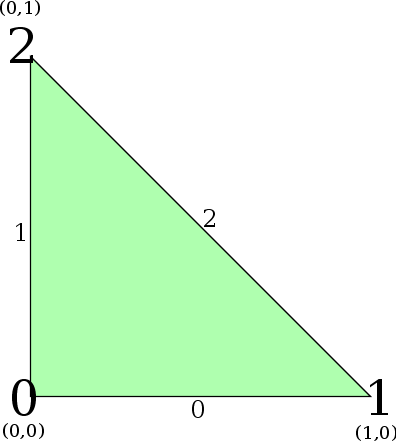
- Three-dimensional reference simplex (a.k.a. tetrahedron)
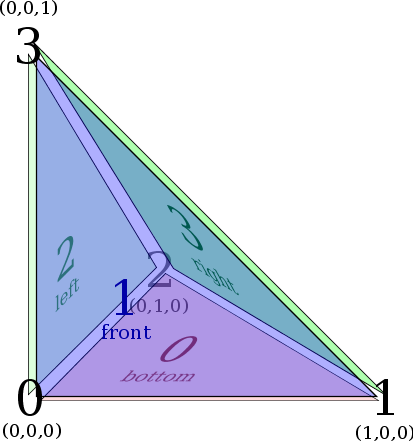 Face Numbering
Face Numbering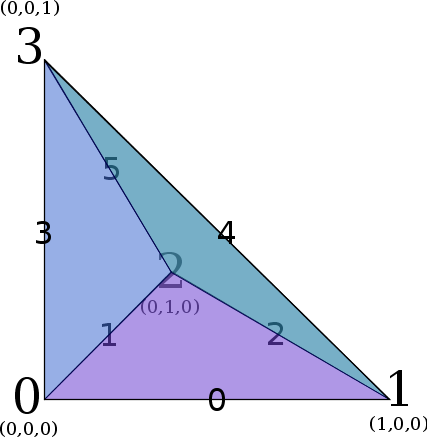 Edge Numbering
Edge Numbering - Two-dimensional reference cube (a.k.a. quadrilateral)
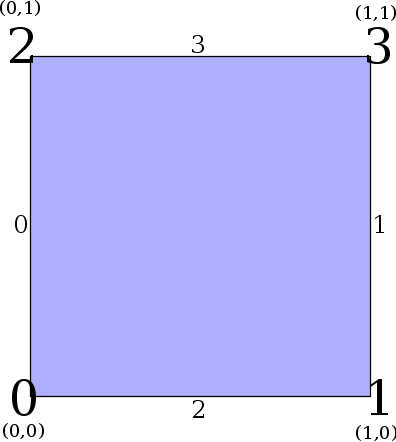
- Three-dimensional reference cube (a.k.a. hexahedron)
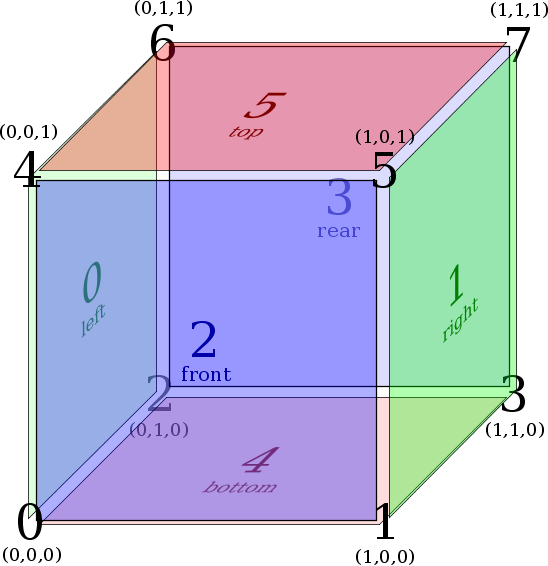 Face Numbering
Face Numbering Edge Numbering
Edge Numbering - Prism reference element
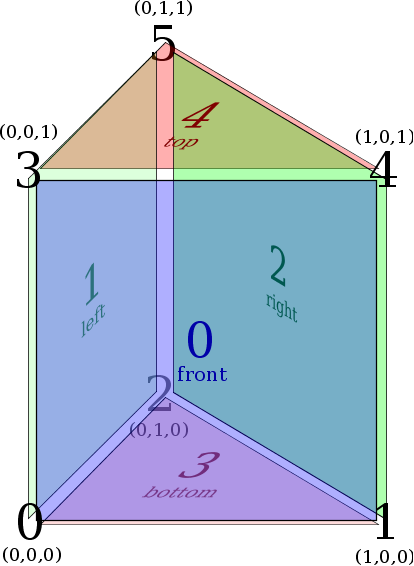 Face Numbering
Face Numbering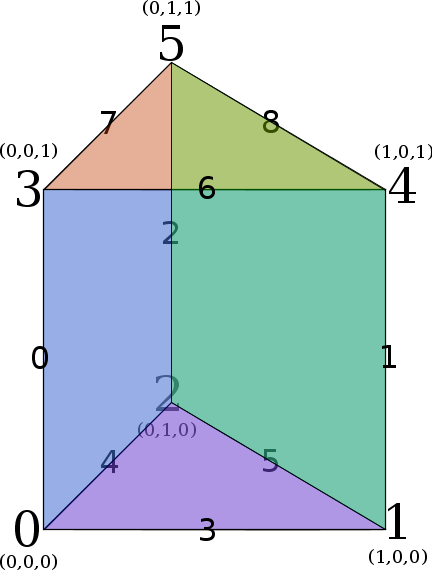 Edge Numbering
Edge Numbering - Pyramid reference element
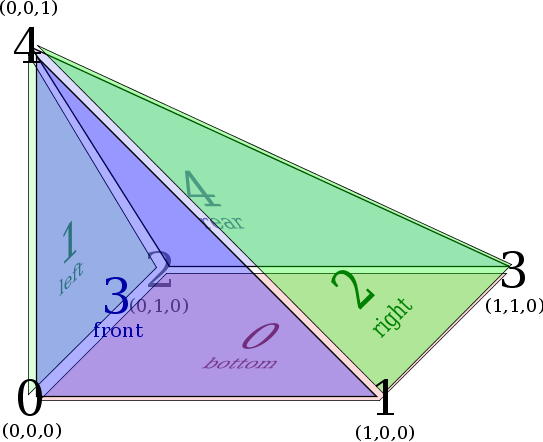 Face Numbering
Face Numbering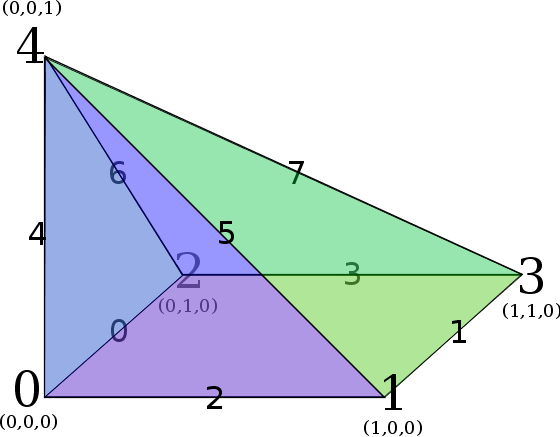 Edge Numbering
Edge Numbering
In addition to the numbering and the corner coordinates of a reference element \( \hat{E} \) we also define the barycenters \( b(\hat{E}) \), the volume \( |\hat{E}| \) and the normals \( n_i(\hat{E}) \) to all codimension one subelements.
The recursion formula is also used to define mappings from reference elements \( E \) to general polytop given by a set of coordinates for the corner points - together with the mapping \( \Phi \), the transpose of the Jacobian \( D\Phi^T(x)\in\mathbf{R}^{d,w} \) is also defined where \( d \) is the dimension of the reference element and \( w \) the dimension of the coordinates. This suffices to define other necessary parts of a Dune geometry by LQ-decomposing \( D\Phi^T \): let \( D\Phi^T(x) = LQ \) be given with a lower diagonal matrix \( L\in \mathbf{R}^{d,d} \) and a matrix \( Q\in\mathbf{R}^{d,w} \) which satisfies \( Q Q^T = I \):
- Jacobian inverse transpose
\[ D\Phi(x)^{-T}:=Q^T L^{-1}. \]
- Integration element
\[ \sqrt{\mathrm{det}(D\Phi(x)^T D\Phi(x))} = \sqrt{\mathrm{det}(LL^T)} = \Pi_{i=1}^d l_{ii}. \]
- Volume
\[ \int_{\hat{E}} \Pi_{i=1}^d l_{ii}(x) d\;x = |\hat{E}| \Pi_{i=1}^d l_{ii}(b(\hat{E})). \]
(Here some assumptions on the degree of the integration element is used.)
The next sections describe the details of the construction.
Reference Topology
We define the set \(\mathcal{T}\) of reference topologies by the following rules:
- \(\mathcal{T}\) contains an element \(\mathbf{p}\) that we call the point topology.
- For \(T \in \mathcal{T}\), \(\mathcal{T}\) contains an element \(T^\vert\) that we call the prism over \(T\).
- For \(T \in \mathcal{T}\), \(\mathcal{T}\) contains an element \(T^\circ\) that we call the pyramid over \(T\).
For each reference topology \(T\) we define the following values:
- Dimension: The point topology has dimension zero and the dimension of a prism or a pyramid topology over \(t\) has dimension \(d(t)+1\).
- Size: For \(c=0,\dots,d\) with \(d=d(T)\) we define the number \(s_c(T)\) through
- \(s_0(T)=1\).
- If \(T=t^\vert\) then \(s_d(T)=2s_{d-1}(t)\) and for \(c\in \{1,\dots,d-1\}\) we have \(s_c(T)=s_{c}(t)+2s_{c-1}(t)\).
- If \(T=t^\circ\) then \(s_d(T)=s_{d-1}(t)+1\) and for \(c\in \{1,\dots,d-1\}\) we have \(s_c(T)=s_{c-1}(t)+s_{c}(t)\).
- Subtopology: Given a reference topology \(T\) of dimension \(d\) and a codimension \(c=0,\dots,d\) we now define the subtopology \(S_{c,i}(T)\in\mathcal{T}\) for \(i=1,\dots,s_c(T)\):
- \(S_{0,1}(T)=T\) and \(S_{d,i}(T)=\mathbf{p}\)
- For \(T=t^\vert\) and \(c\in \{1,\dots,d-1\}\) we define using the abbreviations \(p=s_{c}(t),q=s_{c-1}(t)\)
\[S_{c,i}(T) = \left\{\begin{array}{ll} S_{c,i}(t)^\vert & \mbox{for}\; i=1,\dots,p, \\ S_{c-1,i-p}(t) & \mbox{for}\; i=p+1,\dots,p+q, \\ S_{c-1,i-p-q}(t) & \mbox{for}\; i=p+q+1,\dots,p+2q. \end{array}\right. \]
- For \(T=t^\circ\) and \(c\in \{1,\dots,d-1\}\) we define using the abbreviations \(p=s_{c}(t),q=s_{c-1}(t)\)
\[S_{c,i}(T) = \left\{\begin{array}{ll} S_{c-1,i}(t) & \mbox{for}\; i=1,\dots,q, \\ S_{c,i-q}(t)^\circ & \mbox{for}\; i=q+1,\dots,q+p. \end{array}\right. \]
Notice that the number of vertices (i.e., subtopologies of codimension \(d(T)\)) of a topology \(T\) does not uniquely identify the topology. To see this, consider the topologies \(T_1 = \mathbf{p}^{\vert\vert\vert\circ\circ}\) and \(T_2 = \mathbf{p}^{\circ\circ\circ\circ\vert}\). For these topologies we have \(s_d( T_1 ) = s_d( T_2 ) = 10\).
Reference Domains
For each reference topology \(T\) we associate the set of corners \(\mathcal{C}(T):=(p_i(T))_{1=1}^{s_d(T)}\subset\mathbf{R}^d(T)\) defined through
- \(T=\mathbf{p}\): \(p_0(T)=0\in\mathbf{R}^0\)
- \(T=t^\vert\): \(p_k(T)=(p_k(t),0),p_{d'+k}(T)=(p_k(t),1)\) for \(k=1,\dots,d'\), with \(d'=s_d(t)\).
- \(T=t^\circ\): \(p_k(T)=(p_k(t),0)\) for \(k=1,\dots,d-1\) and \(p_d(T)=e_d\) with \(d=s_d(T)\)
The convex hall of the set of points \(\mathcal{C}(T)\) defines the reference domain \(\mathrm{domain}(T)\) for the reference topology \(T\); it follows that
- \(\mathrm{domain}( \mathbf{p} ) := \lbrace 0 \rbrace \subset \mathbf{R}^0\),
- \(\mathrm{domain}( T^\vert ) := \mathrm{domain}( T ) \times [0,1]\),
- \(\mathrm{domain}( T^\circ ) := \lbrace ((1-\bar{x})x,\bar{x}) \mid x \in \mathrm{domain}( T ), \bar{x} \in [0,1] \rbrace\).
Reference Elements and Mappings
A pair \(E=(T,\Phi)\) of a topology \(T\) and a map \(\Phi:\mathrm{domain}( T ) \to \mathbf{R}^w\) with \(w\geq d(T)\) is called an element.
The reference element is the pair \(E(T)=(T,{\rm id})\).
For a given set of points \(\mathcal{C}:=(p_i)_{1=1}^{s_d(T)}\subset\mathbf{R}^w\) we define a mapping \(\Phi_T(\mathcal{C},\cdot)\mathrm{domain}( T ) \to \mathbf{R}^w\) through \(\Phi_T(\mathcal{C};p_i(T))=p_i\) for all \(p_i(T)\in \mathcal{C}(T)\). This mapping can be expressed using the recursive definition of the reference topologies through:
- \(\Phi_{\mathbf{p}}( (p_0) ; x ) = p_0\),
- \(\Phi_{T^\vert}( (p_1,\ldots,p_{s_d(T^\vert)} ; (x,\bar{x}) ) = (1 - \bar{x}) \Phi_T( p_1,\ldots,p_{s_d(T)} ; x ) + \bar{x} \Phi_T( p_{s_d(T)+1},\dots,p_{s_d(T^\vert)} ; x )\) with \(x\in \mathrm{domain}( T )\) and \(\bar{x}\in[0,1]\).
- \(\Phi_{T^\circ}( p_1,\ldots,p_{s_d(T^\circ)}) ; (x,\bar{x}) ) = (1 - \bar{x}) \Phi_T( p_1,\ldots,p_{s_d(T)-1} ; x ) + \bar{x} p_{s_d(T^\circ)} \) with \(x\in \mathrm{domain}( T )\) and \(\bar{x}\in[0,1]\).
Numbering of Subelements
Given a reference topology \(T\), a codimension \(c\in\{0,\dots,d(T)\}\) and a subtopology \(S_{c,i}(T)\) we define a subset of the corner set \(\mathcal{C}(T)\) \( \mathcal{C}_{c,i}(T)= (p_{k_j}(T))_{j=1}^{s_{d(S_{c,i}(T)}(S_{c,i}(T))} \) given by the subsequence \( \mathcal{K}_{c,i}(T)=(k_j)_{j=1}^{s_{d(S_{c,i}(T)}(S_{c,i}(T))} \) of \( \{1,dots,s_{d(T)}(T)\} \):
\( \mathcal{C}_{0,0}(T) = \mathcal{C}(T)\), \( \mathcal{C}_{d(T),i}(T) = (p_i(T)) \), and for \(c\in\{1,\dots,d(T)-1\}\) we define \( \mathcal{K}_{c,i}(T)=(k_j)_{j=1}^{s_{d(S_{c,i}(T)}(S_{c,i}(T))} \) through the recursion
- \(T=t^\vert\):
For \( i=1,\dots,s_c(T) \) we define \( \mathcal{K}_{c,i}(T)=(k_1,\dots,k_n, k_1+s_{d(t)}(t)\dots,k_n+s_{d(t)}(t)) \) with \( \mathcal{K}_{c,i}(T)= \{k_1,\dots,k_n\} \).
For \( i=s_(T)+1,\dots,s_c(T)+s_{c+1}(T) \) we define \( \mathcal{K}_{c,i}(T)=(k_1,\dots,k_n) \) with \( \mathcal{K}_{c-1,i}(T)= \{k_1,\dots,k_n\} \).
For \( i=s_c(T)+s_{c+1}(T)+1,\dots,s_c(T)+2s_{c+1}(T) \) we define \( \mathcal{K}_{c,i}(T)=(k_1+s_{d(t)}(t),\dots,k_n+s_{d(t)}(t)) \) with \( \mathcal{K}_{c-1,i}(T)= \{k_1,\dots,k_n\} \). - \(T=t^\circ\):
For \( i=1,\dots,s_{c-1}(T) \) we define \( \mathcal{K}_{c,i}(T)=(k_1,\dots,k_n) \) with \( \mathcal{K}_{c-1,i}(T)= \{k_1,\dots,k_n\} \).
For \( i=s_{c-1}(T)+1,\dots,s_{c-1}(T)+s_c(T) \) we define \( \mathcal{K}_{c,i}(T)=(k_1,\dots,k_n,s_{d(T)}(T)) \) with \( \mathcal{K}_{c-1,i}(T)= \{k_1,\dots,k_n\} \).
Given these subsets we define subreference elements \(E_{c,i}(T)=(S_{c,i}(T),\Phi_{c,i}(T))\) of \(E(T)\) given by the following mapping \( \Phi_{c,i}(T,\cdot)=\Phi(S_{c,i}(T),\mathcal{C}_{c,i}(T),\cdot) \).
Furthermore we define a numbering of the subreference elements of each subreference element in \(T\). This is the number \( k=\mathrm{index}_{c,i,cc,ii}(T)\) for \(c\in\{0,\dots,d(T)\}\), \( i\in\{1,\dots,s_c(T)\} \), and \( cc\in\{0,\dots,d(S_{c,i})\}\), \( ii\in\{1,\dots,s_{cc}(S_{c,i})\} \) for which
\[\Phi_{c,i}(S_{c,i}(T))\circ \Phi_{cc,ii}(S_{cc,ii}(S_{c,i}(T))) = \Phi_{c+cc,k}(T).\]
Function Documentation
◆ referenceElement() [1/3]
| auto Dune::referenceElement | ( | const Dune::GeometryType & | gt, |
| Dune::Dim< dim > | = {} |
||
| ) |
Returns a reference element of dimension dim for the given geometry type and coordinate field type.
This function allows you to obtain a reference element for a given coordinate type, dimension and GeometryType:
◆ referenceElement() [2/3]
| auto Dune::referenceElement | ( | const T & | , |
| const Dune::GeometryType & | gt, | ||
| Dune::Dim< dim > | |||
| ) |
Returns a reference element of dimension dim for the given geometry type and coordinate field type.
This function allows you to obtain a reference element for a given coordinate type, dimension and GeometryType:
References Dune::Geo::ReferenceElements< ctype_, dim >::general(), and Dune::FloatCmp::gt().
◆ referenceElement() [3/3]
| unspecified value type Dune::referenceElement | ( | T &&... | t | ) |
Returns a reference element for the objects t....
The freestanding function referenceElement is a generic entry point for getting reference elements for arbitrary objects that support the operation. As it relies on argument-dependent lookup, the function should be called without any qualifying namespace. Note, however, that the versions of referenceElement() for a dimension and GeometryType with explicit template arguments cannot be found by ADL, so you have to explicitly pull them in or qualify the call using Dune:::
The returned object is guaranteed to have value semantics, so you can copy it around and store it by value.
The grid geometries in dune-grid support this function, and thus most people will use this function as
This does of course also work for entities of other codimensions.
Referenced by Dune::PDELab::RT0Constraints::boundary(), Dune::PDELab::ConformingDirichletConstraints::boundary(), Dune::IntersectionDefaultNormalVectors< GridImp, IntersectionImp >::centerUnitOuterNormal(), Dune::HierarchicSearch< Grid, IS >::findEntity(), Dune::HierarchicSearch< Grid, IS >::hFindEntity(), Dune::Functions::LeafPreBasisMapperMixin< GV >::initializeIndices(), Dune::Functions::Experimental::SubDomainIndexSet< HGV >::insertElement(), Dune::VertexOrderByIdFactory< IdSet, Index >::make(), Dune::PDELab::OverlappingConformingDirichletConstraints::processor(), Dune::PDELab::HangingNodesDirichletConstraints< Grid, HangingNodesConstraintsAssemblerType, BoundaryFunction >::skeleton(), and Dune::PDELab::NonoverlappingConformingDirichletConstraints< GV >::volume().
 |
Legal Statements / Impressum |
Hosted by TU Dresden & Uni Heidelberg |
generated with Hugo v0.111.3
(Nov 9, 23:40, 2025)
|
Legal Statements / Impressum |
Hosted by TU Dresden & Uni Heidelberg |
generated with Hugo v0.111.3
(Nov 9, 23:40, 2025)